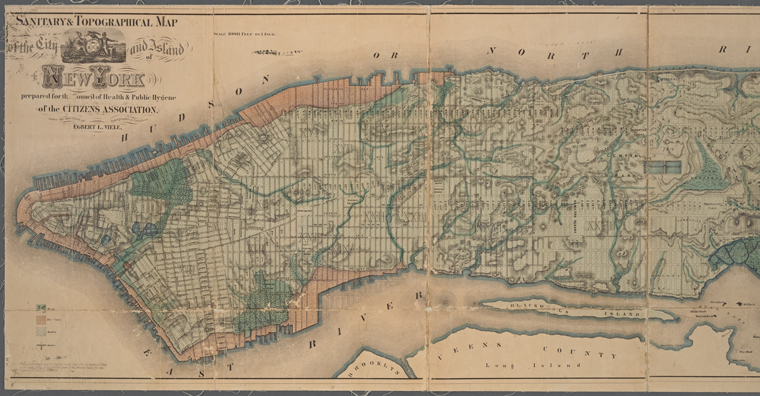Located between Mount Sinai Hospital and the Museum Mile, New York Academy of Medicine is home to over half a million volumes, including a comprehensive collection of rare books and artifacts. I met with Arlene, the Reference Librarian of Historical Collections, in the gilded marble lobby of the Academy, where she brought me up to the Drs. Barry and Bobbi Coller Rare Book Reading Room.
Although it was originally intended only for the use of the Academy’s Fellows, the Library opened its doors to the public in 1878–about thirty years after its inception. The library grew rapidly throughout the late-nineteenth and early-twentieth centuries, expanding its collection mainly through personal and institutional donations from the Medical Journal Association, the Society of the New York Hospital, and the medical books of the New York Public Library. The Rare Book Room houses thousands of books, manuscripts, pamphlets, and artifacts relating the history not only to the history of medicine, but also natural history, philosophy, and the history of print.
Arlene was excited to show me some of the collection’s highlights, including a hand-painted first edition of Conrad Gessner’s Historiae animalium, pictured below. Gessner’s book–one of the most carefully-colored copies I’ve ever seen–speaks to a key concern of rare books libraries: that is, a preoccupation with the singular object. When every object is unique, “form and substance are indistinguishable.” (Cloonan, 236). The Library holds multiple copies of Gessner’s volume, each unique in coloration, providence, and form.
These differences are carefully accounted for in the card catalogue, but what is particularly interesting is the fact that the majority of these details have been lost in the catalogue’s migration to the digital realm. Arlene explained how the temporary staff who created the metadata were not so careful in their work; not everything was catalogued or catalogued in sufficient detail. In effect, the particularities of the books as objects has been lost for users trying to access them online. As a center for this history of print, the Academy Library takes such considerations seriously.
For example, I was shown a copy of a seventeenth-century natural history textbook in which its eighteenth-century owner added a watercolor observation of a beached whale. Arlene explained how, although the whale drawing is accounted for in the card catalogue, she wasn’t aware of it until a patron found it while doing research.
Another example is an anatomy textbook with fore-edge paintings of William Harvey, John Hunter, and Edward Jenner. Although the book plate within describes the paintings, no where are they noted on the digital catalogue. The problems this raises in terms of accessibility of information are central to the concerns Arlene discussed with me.
In terms of the digital preservation, the library has not begun a comprehensive digitization project, but instead digitizes material for online exhibits. While the Library has hired freelance digitizers from time-to-time, the volume of work they can get done is often limited. The main problem seems to be lack of adequate funding for long-term digitization projects beyond money from federal grants. Moreover, further problems arise with conservation when rare material is handled for digitization–a threat that is perhaps not worth it for the librarians at NYAM in the long run. Archivists and librarians are well aware of scholars’ “failure to understand the pressures that make it impossible to save everything.” (Rosenzweig, 760). At the NYAM LIbrary, thousands of volumes of journals and theses had to be given away because of lack of space. This idea perhaps extends to the pressure to digitize rare material, which is not always technically or fiscally viable.
The main concerns of the collection’s librarians, therefore, revolve around conservation and access. The Library opened its Conservation Lab in 1982 with the aim to preserve its collection for future generations. Focusing on item-level treatment and storage considerations, the Lab is largely funded by grants and donations. Larger conservation projects, focusing on specific themes or bodies of work, therefore only occur once or twice a year. Facing a lack of funding, NYAM’s rare book librarians have been focusing more on smaller projects of careful storage, bounding up delicate books within acid-free supports and shrink wrap.
In this case, the digital collection is therefore more about access and the production of a coherent heritage. Arranged in online exhibitions, the Library’s digital collection speaks to the project of arranging historical material into a consistent narrative. The collection and preservation of heritage by institutions creates a “social memory by which popular significance becomes based on memory stores and historical materials. Therefore, ‘significance’ is consensual, but also hegemonic because it is shaped by practices and meta-cultures that characterize their transmission” (Dalbello, 1). As an adjunct of the New York Academy of Medicine, the library’s heritage, like many rare book collections, is primarily based in hegemonic culture. While the digital exhibits and cultural programming provided by NYAM showcase facets of their incredible collection, such a limited view and incomplete catalogue stifles access and intellectual comprehension.
References
Cloonan, M.V. (2001). “W(h)ither preservation?” The Library Quarterly 71(2): 231-42.
Dalbello, M. (2009). “Digital culture heritage: concepts, projects, and emerging constructions of heritage.” Proceedings of the Libraries in the Digital Age (LIDA) Conference. 25-30 May, 2009.
The New York Academy of Medicine — Library. Retrieved from http://www.nyam.org/library/.
Rosenzweig, R. (2003). “Scarcity or abundance? Preserving the past in a digital era.” The American Historical Review 108(3): 735-763.








